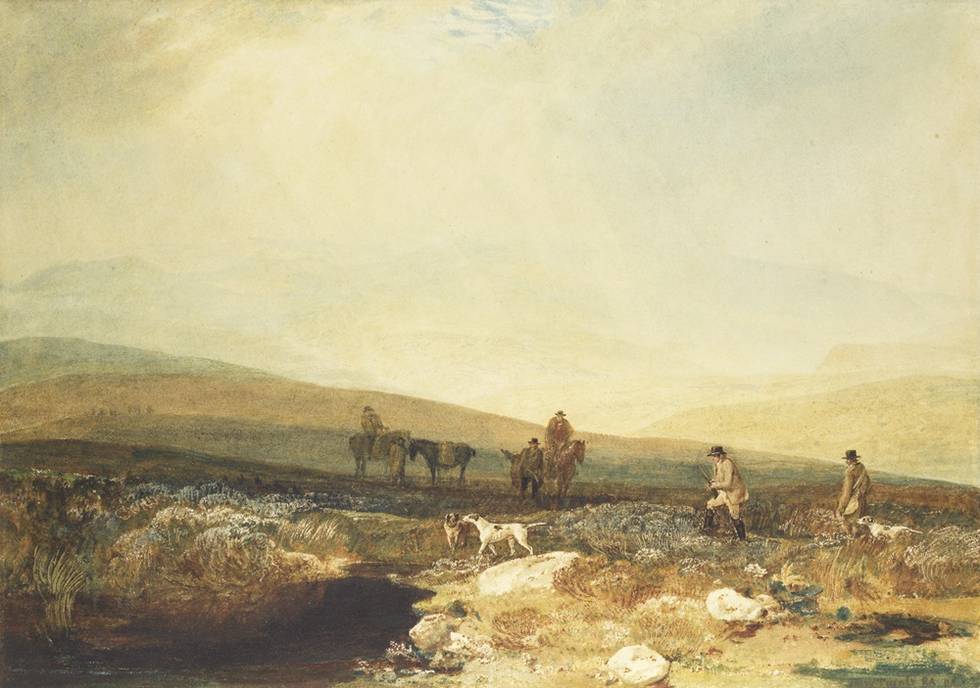This watercolour has often been discussed as a pendant to Woodcock Shooting at Otley Chevin, which is the same size and is connected in theme (the shooting of game), although they may not be contemporary.
This is one of Turner’s earliest representations of the Yorkshire moors and shows a shooting party of two men on horseback accompanied by four men on foot, one recently dismounted and leading his horse. The carriage of the pointer dog in the centre indicates that he has picked up the scent of grouse. He is followed by the two men on foot, with guns, while the others appear to be in the process of dismounting.

The painting is a remarkable study of the topography and atmosphere of moorland. The figures are very small in proportion to the vast expanse of moor and appear to be contained within its very contours. Distant peaks are obscured by low, heavy cloud, suggesting rain, but with sunlight breaking through in places. As in the woodcock shooting scene, we are offered a detailed foreground, with rough bracken, heather and rocks, and a dark peaty bog where Turner has added ink and gum arabic to make the colour as opaque as possible – the paint is in fact unusually dense for a watercolour. The highlights of the heather have been scratched out, creating a textured surface, and he may also have added white paint in these areas. In contrast to the application of dry paint to the foreground, the distant contours of the moors have been painted in thin, transparent washes. As with its pendant, the painting is an impressive depiction of late summer or early Autumn with the raking light of the sun breaking through the low cloud.
Turner has signed his name in a little bog in the bottom right corner: ‘Turner RA PP, professor of Perspective’, a post he took up in 1807. In doing so, once again, he implies his own participation in the scene depicted. Turner was in fact an enthusiastic participant in the shooting parties that were held by Walter Fawkes at Farnley, and a number of his sketchbooks represent scenes from the lavish and large-scale shooting parties that were held on the vast estate.
This watercolour, which is not dated, has been linked to a sketch in the Large Farnley Sketchbook that has been identified as the shooting party at Beamsley Beacon of 1816, at which, on the second day, Walter Fawkes’s brother Richard was fatally wounded. The second figure from the right, carrying a gun, has been identified as Turner, and the mounted figure to the left of him as Richard Fawkes, who was married to William Pilkington’s niece, Isabella. It seems somewhat unlikely that Turner or William Pilkington would wish to commemorate such a tragic event.
Nonetheless, the dating of the sketch to the summer of 1816 seems correct because it appears in the sketchbook immediately before the Hackfall drawings that can be confidently dated to that summer when Turner, shortly after the death of Richard Fawkes, undertook a sketching tour of Yorkshire accompanied at some stage by the bereaved Walter Fawkes and his family. Turner chose Hackfall as one of the spectacular views of Yorkshire for the projected seven-volume History of Yorkshire by Dr Whittaker.
The watercolour was catalogued at the Elhanan Bicknell sale of 1863 as ‘Grouse shooting, the Moor, with portrait of the Artist, the dogs painted by Stubbs.’
Henry James admired the four watercolours by Turner on exhibition at the Bethnal Green Museum during his visit in 1873. He particularly praised Grouse Shooting as a work in which ‘it is hard to imagine anything more masterly than the sustained delicacy of the gradations which indicate the shifting mixture of sun and mist… the foreground here is as fine as the distance; half a dozen white boulders gleam through the heather beside a black pool with the most naturally picturesque effect.’